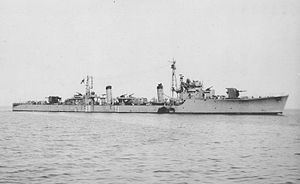 Sister ship Momi, 4 September 1944
| |
| History | |
|---|---|
| Name | Sugi |
| Namesake | Cedar |
| Builder | Fujinagata Shipyards, Osaka |
| Laid down | 25 February 1944 |
| Launched | 3 July 1944 |
| Completed | 25 August 1944 |
| Fate | Transferred to the Republic of China Navy, 31 July 1947 |
| Name | ROCS Hui Yang |
| Acquired | 31 July 1947 |
| Stricken | 11 November 1954 |
| Fate | Scrapped, after 11 November 1954 |
| General characteristics (as built) | |
| Class and type | Matsu-class escort destroyer |
| Displacement | 1,282 t (1,262 long tons) (standard) |
| Length | 100 m (328 ft 1 in) (o/a) |
| Beam | 9.35 m (30 ft 8 in) |
| Draft | 3.3 m (10 ft 10 in) |
| Installed power | 2 × water-tube boilers; 19,000 shp (14,000 kW) |
| Propulsion | 2 shafts, 2 × geared steam turbines |
| Speed | 27.8 knots (51.5 km/h; 32.0 mph) |
| Range | 4,680 nmi (8,670 km; 5,390 mi) at 16 knots (30 km/h; 18 mph) |
| Complement | 210 |
| Sensors and processing systems | |
| Armament |
|
Sugi (杉, "Cedar") was one of 18 Matsu-class escort destroyers built for the Imperial Japanese Navy (IJN) during World War II. Completed in mid-1944, the ship played a minor role in the Battle off Cape Engaño in October, escorting aircraft carriers and then began escorting convoys. She was damaged during the Battle of Ormoc Bay in December escorting a troop convoy in the Philippines and then escorted cruisers on a bombardment mission during Operation Rei later that month. Sugi was damaged again by American aircraft during the South China Sea raid in January 1945 and then escorted a convoy back to Japan in February where she was repaired.
Inactive for the rest of the war, she was surrendered to the Allies at the end of the war and used to repatriate Japanese troops until 1947. Mid-year the destroyer was turned over to the Republic of China and renamed Hui Yang. The ship was not placed back in commission and was cannibalized for spare parts until she was stricken in 1954 and subsequently scrapped.